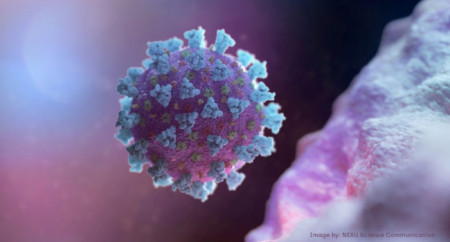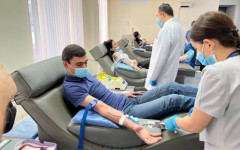Scientists identify marker of dangerous form of COVID-19 infection

The Italian and Australian scientists have discovered a marker of a dangerous form of COVID-19 infection that can lead to the death of a patient.
According to a study published in the International Journal of Infectious Diseases, the level of serum amyloid protein in critically ill patients becomes abnormally high during an acute reaction of the body to the SARS-CoV-2 coronavirus.
Health Europe reported that scientists conducted a meta-analysis of studies from the PubMed, Web of Science, and Scopus databases, which examined the link between the severity of COVID-19 symptoms, serum amyloid A (SAA) protein concentrations in patients with coronavirus, and patient survival. A total of 19 studies were included in the meta-analysis, which involved a total of 5617 patients with COVID-19. At the same time, in 3723 people (49%) the disease was mild or moderate.
Analysis of the results showed that SAA concentrations were significantly high in those patients who did not survive or who had a very severe form of COVID-19. The standardized mean difference (SMD) between the mild and severe patient groups was 1.20 with a 95% confidence interval of 0.91-1.49, indicating a strong relationship between high SAA values and severe COVID-19. Scientists have also found a link between amyloid A levels and gender, which may explain why men are more vulnerable to the virus.
Tracking SAA, which serves as a sign of severe complications of the disease, could be useful in identifying risk groups and monitoring the condition of patients with coronavirus infection, scientists said.
SAA is significantly activated during the acute phase response - a general body response that develops in response to the release of cytokines during infection. The normal concentration of amyloid A is 20-50 milligrams per liter, but it can increase up to 1000 times during the first 24-48 hours of the acute phase response. This is due to increased protein production in the liver, which is triggered in response to stimuli such as interferon-gamma, interleukin-1β and -6, and tumor necrosis factor (TNF). In turn, SAA enhances inflammation by increasing the synthesis of these stimuli and activating other pro-inflammatory cytokines that can cause cytokine storms and other complications in COVID-19.
 The Power of One Dram to the Road of Life Charitable Organization
The Power of One Dram to the Road of Life Charitable Organization
 AMIO bank issues bonds
AMIO bank issues bonds
 General Director of Ucom gave a lecture at the French University in Armenia
General Director of Ucom gave a lecture at the French University in Armenia
 Amio Bank participated in Career City Fest 2K24
Amio Bank participated in Career City Fest 2K24
 Transfers to Visa cards of foreign banks are available in the Unibank mobile app
Transfers to Visa cards of foreign banks are available in the Unibank mobile app
 ZCMC CJSC general director R.N. Khudoli on the օccation of Internatioanal Labour day
ZCMC CJSC general director R.N. Khudoli on the օccation of Internatioanal Labour day
 Gagik Khachatryan's prolonged denial of medical care amounts to torture. attorney
Gagik Khachatryan's prolonged denial of medical care amounts to torture. attorney
 More and more smiles in the city. 'Kentron' branch of AMIO BANK was reopened
More and more smiles in the city. 'Kentron' branch of AMIO BANK was reopened
 Idram and IDBank at Career City Fest
Idram and IDBank at Career City Fest
 Idram and IDBank as participants of Career City Fest
Idram and IDBank as participants of Career City Fest
 Ucom provides four bus stops in Ijevan with free Wi-Fi
Ucom provides four bus stops in Ijevan with free Wi-Fi
 An exhibition dedicated to Charles Aznavour's centennial anniversary Yerevan, May 22 – July 22
An exhibition dedicated to Charles Aznavour's centennial anniversary Yerevan, May 22 – July 22
 Caring for nature, we have started with ourselves - Team Telecom Armenia
Caring for nature, we have started with ourselves - Team Telecom Armenia
 Up to 10% cashback from GetTransfer with IDBank cards
Up to 10% cashback from GetTransfer with IDBank cards
 Amio Visa Signature Business card. When the opportunities are unlimited
Amio Visa Signature Business card. When the opportunities are unlimited
 Up to 1% cashback when shopping on Wildberries with IDBank cards
Up to 1% cashback when shopping on Wildberries with IDBank cards
 Ucom continues network modernization in regions of Armenia
Ucom continues network modernization in regions of Armenia
 Co-founders of Galaxy Group of Companies Co-Hosts Business Breakfast to Strengthen Armenian-French Business Ties
Co-founders of Galaxy Group of Companies Co-Hosts Business Breakfast to Strengthen Armenian-French Business Ties
 Leasing agreement and a number of advantages. Amio is in the Leasing Expo with a special offer
Leasing agreement and a number of advantages. Amio is in the Leasing Expo with a special offer
 International transfers from card to card with IDBank VISA cards
International transfers from card to card with IDBank VISA cards
 Which Book to Choose as a Gift for the Book Giving Day? A Piece of Advice from Idram and IDBank
Which Book to Choose as a Gift for the Book Giving Day? A Piece of Advice from Idram and IDBank
 The Christmas gift from the Galaxy Group of Companies is the restoration of a song extricated by
Khrimian Hayrik
The Christmas gift from the Galaxy Group of Companies is the restoration of a song extricated by
Khrimian Hayrik
 Galaxy Group of Companies replaced the traditional New Year's gifts with houses of kindness and peace crafted by the chi...
Galaxy Group of Companies replaced the traditional New Year's gifts with houses of kindness and peace crafted by the chi...
 Ucom օffers combining mobile and fixed services in Unity packages and save up to 45%
Ucom օffers combining mobile and fixed services in Unity packages and save up to 45%
 I personally promised the greatest athlete that he will definitely witness the eternity of his own fame. Gagik Tsarukyan...
I personally promised the greatest athlete that he will definitely witness the eternity of his own fame. Gagik Tsarukyan...
 Donate blood, help to live
Donate blood, help to live
 The Blessing and the handover of the Crosses of Ashot II the Iron under the sponsorship of Tovmasyan Foundation
The Blessing and the handover of the Crosses of Ashot II the Iron under the sponsorship of Tovmasyan Foundation




